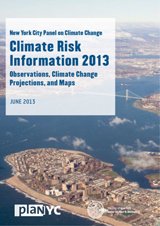New York City Assesses Heat Event Risk

Heat waves are one of the leading weather-related causes of death in the Unites States. Recognizing the current and future heat risk to its population, NYC decided to assess risks and vulnerabilities.
To assess the risk of future heat events, the New York City Panel on Climate Change (NPCC) used the most up-to-date global climate models at the time. The NPCC's Climate Risk Information Report identified a baseline (covering the period 1970-2000) of two heat waves per year on average. NYC projected the number of heat waves could increase (using the 90th percentile as the high estimate) to seven per year by 2050. Additionally, the NPCC's 2013 report states the average annual number of days over 90°F could more than triple (under the high estimate) from 18 to 57 by 2050.
NYC updated its emergency response and hazard mitigation plans as a result of its Climate Risk Information Report. New York City is continuing to refine their future projections to better assess risk and vulnerability under the best-available science. The most recent update was in the NPCC 2024 Report "NPCC4: New York City Climate Risk Information 2022—Observations and Projections," which includes projections to the year 2100.
| How Did They Do It? | Applicable EPA Tools |
|---|---|
Assessed potential hazards and impacts.
| EDDE, The EPA Dynamically Downscaled Ensemble, is a collection of physics-based modeled data that represent historical and future atmospheric conditions under different scenarios. The EDDE datasets can be used to explore potential changes to environmental conditions across the contiguous United States from the recent historical period out to 2100 to quantify potential impacts on human health and the environment. |
Incorporated future risk within preparedness and resilience plans.
| EPA’s Excessive Heat Events Guidebook helps communities identify current and future disaster response needs for adapting and proving resilient to extreme heat climate risk. |
Educate residents on the threats from heat events and provides preparedness resources.
| EPA's Heat Island Outreach Materials can help communities learn more about the risk from heat events. |
Re-assessing vulnerability under the best available science
| CDC’s Heat & Health Tracker helps communities identify populations most at risk from heat events and other hazards and impacts. * (This is a non-EPA resource from the Centers for Disease Control and Prevention.) |
Similar Cases and More Information
Heat events and other weather hazards can disproportionately impact at-risk or vulnerable communities. To view a case study that identified and then actively engaged with vulnerable communities in adaptation planning for heat events, view the Chicago Heat Emergency Response.
To see how a community has used green infrastructure to both reduce the impact of future heat events and reduce stormwater runoff during heavy precipitation events, view Chicago, IL Uses Green Infrastructure to Reduce Heat Event Impacts.
References
- NPCC4: New York City Climate Risk Information 2022—Observations and Projections
- Building the Knowledge Base for Climate Resiliency: New York City Panel on Climate Change 2015 Report
- 2014 New York City Hazard Mitigation Plan (PDF) (550 pp, 67 MB)
- NYC Health: Extreme Heat and Your Health
- Ready New York Guides and Resource
- Climate Risk Information 2013 (PDF)(38 pp, 1.2 MB)
